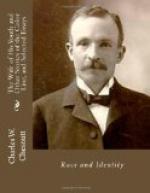A certain well-known Shakspearean actress has a strain of Negro blood, and a popular leading man under a well-known manager is similarly gifted. It would be interesting to give their names, but would probably only injure them. If they could themselves speak of their origin, without any unpleasant consequences, it would be a handsome thing for the colored race. That they do not is no reproach to them; they are white to all intents and purposes, even by the curious laws of the curious States from which they derived their origin, and are in all conscience entitled to any advantage accompanying this status.
Anyone at all familiar with the hopes and aspirations of the colored race, as expressed, for instance, in their prolific newspaper literature, must have perceived the wonderful inspiration which they have drawn from the career of a few distinguished Europeans of partial Negro ancestry, who have felt no call, by way of social prejudice, to deny or conceal their origin, or to refuse their sympathy to those who need it so much. Pushkin, the Russian Shakspeare, had a black ancestor. One of the chief editors of the London Times, who died a few years ago, was a West Indian colored man, who had no interest in concealing the fact. One of the generals of the British army is similarly favored, although the fact is not often referred to. General Alfred Dodds, the ranking general of the French army, now in command in China, is a quadroon. The poet, Robert Browning, was of West Indian origin, and some of his intimate personal friends maintained and proved to their own satisfaction that he was partly of Negro descent. Mr. Browning always said that he did not know; that there was no family tradition to that effect; but if it could be demonstrated he would admit it freely enough, if it would reflect any credit upon a race who needed it so badly.
The most conspicuous of the Eurafricans (to coin a word) were the Dumas family, who were distinguished for three generations. The mulatto, General Dumas, won distinction in the wars under the Revolution. His son, the famous Alexandre Dumas pere, has delighted several generations with his novels, and founded a school of fiction. His son, Alexandre fils, novelist and dramatist, was as supreme in his own line as his father had been in his. Old Alexandre gives his pedigree in detail in his memoirs; and the Negro origin of the family is set out in every encyclopaedia. Nevertheless, in a literary magazine of recent date, published in New York, it was gravely stated by a writer that “there was a rumor, probably not well founded, that the author of Monte-Cristo had a very distant strain of Negro blood.” If this had been written with reference to some living American of obscure origin, its point might be appreciated; but such extreme delicacy in stating so widely known a fact appeals to one’s sense of humor.
These European gentlemen could be outspoken about their origin, because it carried with it no social stigma or disability whatever. When such a state of public opinion exists in the United States, there may be a surprising revision of pedigrees!




